Have you recently taken up running every day and noticed pain in the back of your lower leg? Running is a great way to exercise and benefit the heart and overall body’s muscles, but it can sometimes be accompanied by a condition called Achilles tendinitis, which means there is inflammation in the tendon that attaches to the back of your foot. The calf muscles join at the heel using this tendon, called the ‘Achilles tendon’. Read on to find out the causes of Achilles tendinitis, how it is diagnosed, common symptoms, and how to manage it effectively.
Achilles Tendinitis
Ankle Achilles Tendinitis: Causes, Symptoms, Diagnosis And Treatment
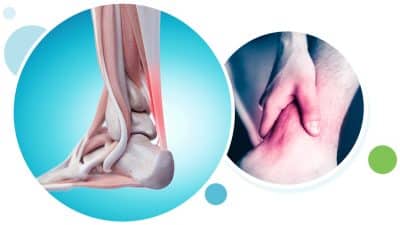
What Causes Ankle Achilles Tendinitis?
This condition is caused by repeated or intense strain on the Achilles tendon, which is a band of fibrous tissue that links your calf muscles to your heel bone. This tendon is used when you are doing a variety of lower body activities, such as walking, running, jumping or raising your heels on your toes.
The Achilles tendon also weakens with age, which ultimately leads to it being more prone to injury. This is especially relevant for those who engage in high-intensity activity on the weekends without proper graduated training, or those who have suddenly increased the intensity of their running regime.
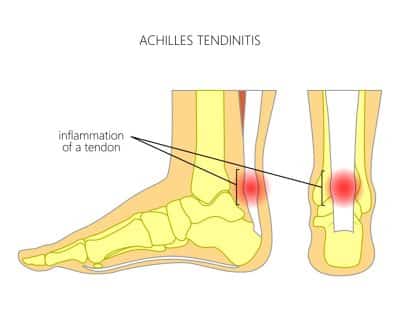
Symptoms
- Starts as a mild ache in the back of the leg or above the heel
- Usually onsets shortly after running or other vigorous sporting activities.
- Longer distance running, climbing stairs or sprinting can also lead to periods of more severe pain
- Tenderness or stiffness below the calf muscles, especially in the morning, may alleviate stiffness with some activity.
How Are Ankle Achilles Tendinitis Diagnosed?
Your physiotherapist will conduct a full movement assessment for the ankle joint, palpate for tenderness, and ask about your activity over the past few days and weeks. Tenderness at the site of the tendon, limited movement and pain during strength assessments can indicate signs that the tendon is inflamed and confirms the diagnosis.
How Do I Manage Ankle Achilles Tendinitis?
It is crucial to treat Achilles Tendinitis when the above symptoms are present, as this condition can weaken the tendon and make it more susceptible to more severe injury in the form of a tear (rupture).
Advice regarding activity modification is a key part of treating Achilles tendinitis. Reducing the amount of activity in the form of running and vigorous sports will be part of reducing the load on the tendon and allowing it to recover effectively. Also, taking anti-inflammatories such as Nurofen can help in alleviating the inflammation in the tendon. Your physio may also recommend an orthotic insert or wedge for your shoe to raise your heel and hence reduce the strain on the tendon. This is a good short-term measure to alleviate the forces acting on your Achilles tendon.
Here are a few exercises your physio would recommend:
1. Calf Stretch
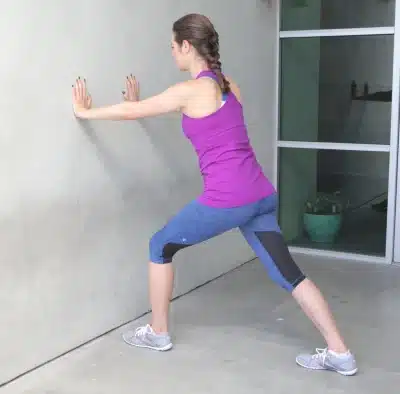
This is a great initial exercise to increase flexibility in the calf muscles and allow the Achilles tendon to reduce stiffness whilst it is recovering. Stand facing a wall (~30cm away) with feet apart. Take one step back with your uninjured leg, lean with your injured leg into the wall, and lean onto the wall to stretch your back leg’s calf, as shown in the image above. Stay at this point for 30 seconds, and do this several times a day, remembering to stay within your pain limits and not push through the pain.
2.Calf raise (lowering phase)
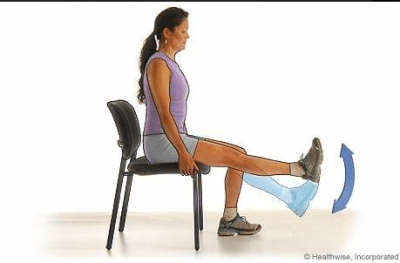
This mid-recovery phase exercise utilises the stretch of the calf muscles during a strength exercise and has been shown to alleviate some pain in Achilles tendinitis cases. Stand with feet shoulder-width apart off a step, and raise your heels and body upwards. Keep your knees straight, and when you get to the top, lift your unaffected heel off the ground, and slowly lower your other heel down over a count of 3 seconds. If you can not tolerate this stretch or pain, just lower both heels instead of one. Complete 3 sets of 10 repetitions, every day.
3. Seated calf raises (weighted)
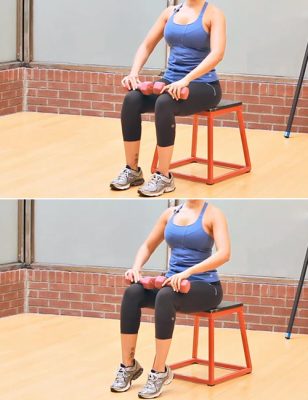
This is a later-phase exercise that involves loading the Achilles tendon more, and increasing its strength. You may need some dumbbells or 2L water bottles to add the extra weight. Sit with your hips, knees and ankles at 90-degree angles, with the dumbbells resting on your knees. Then, rise on your toes with both feet for 3 seconds, and slowly lower your heels back down over another 3-second count. Perform 3 sets of 10 repetitions, and lower or increase the weight load depending on your pain tolerance.
If you are concerned about a potential Achilles tendinitis injury in your ankle/s and want to set up a holistic plan to alleviate the pain and achieve optimal healing and recovery, feel free to Call or Book Online with one of our Bankstown Physiotherapists or Chiropractors today!

New Client Offer - 10% OFF
Are you in pain? Not sure if we can help you?
Book your initial appointment and receive 10% off any service!